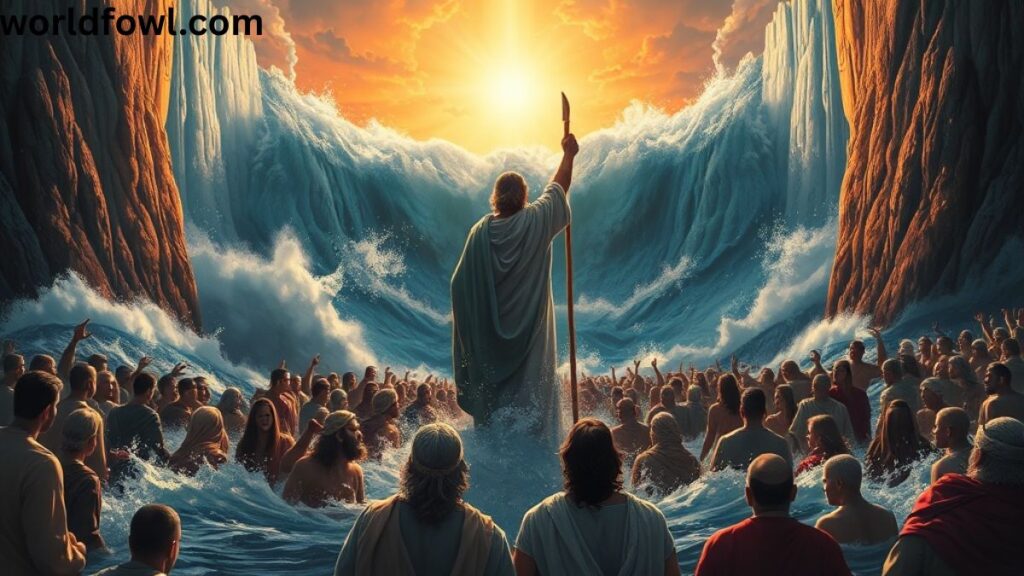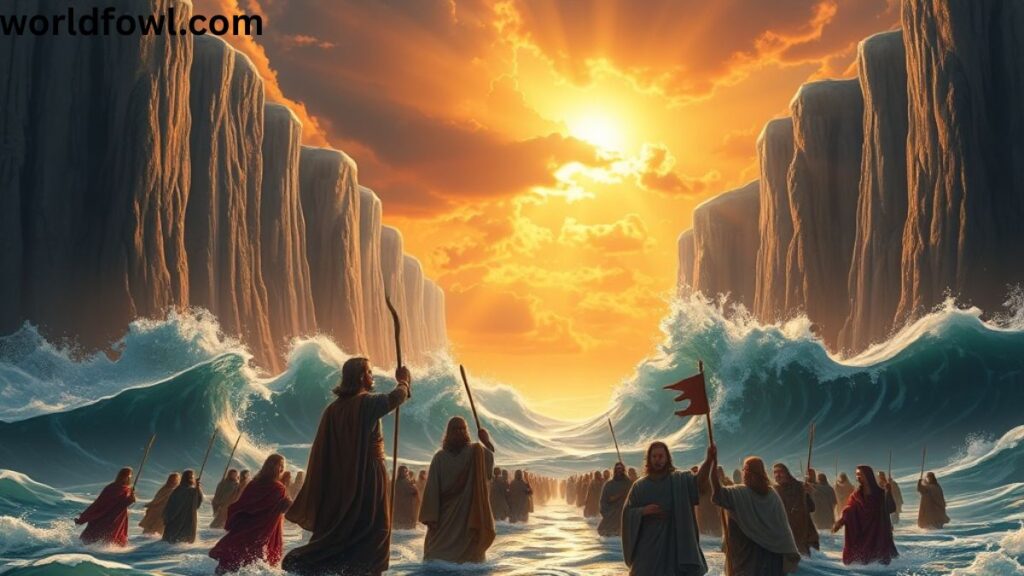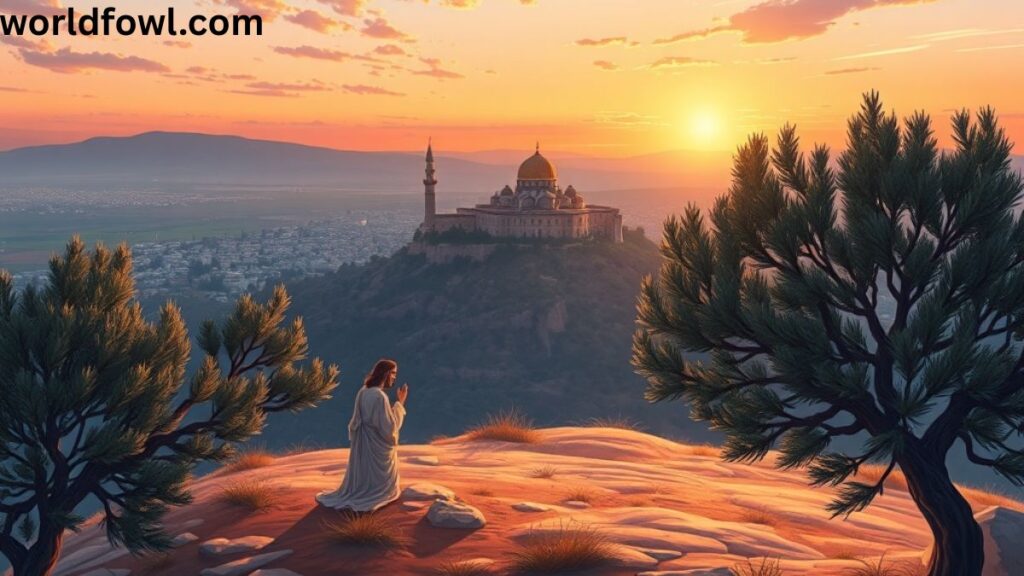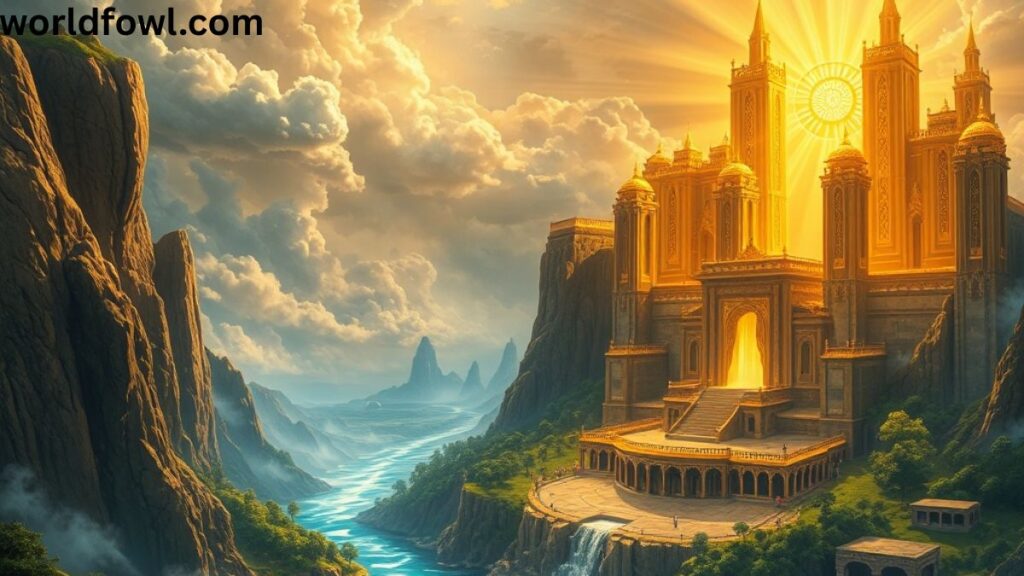The 25 important places in the Bible represent geographical landmarks where divine encounters, miraculous events, and pivotal moments in biblical history unfolded. These sacred locations in the Bible span from the Garden of Eden where creation began to the New Jerusalem where eternity awaits. Each site witnessed God’s promises fulfilled, prophets delivering messages, and Jesus Christ walking among humanity.
25 Important Places in the Bible Every stone tells a story. Every mountain echoes with prayers. From Mount Sinai where God’s law thundered to Calvary where redemption bled, these significant biblical locations transformed ordinary geography into holy ground. Millions have walked these paths seeking connection to stories that shaped civilization itself.
25 Important Places in the Bible These biblical places aren’t dusty relics or forgotten ruins. They’re living testimonies to divine intervention, human faith, and God’s covenant spanning millennia.25 Important Places in the Bible Whether exploring Jerusalem’s ancient walls, standing where the Red Sea parted, or visiting Bethlehem where prophecy became flesh, these locations ground spiritual truth in historical reality—connecting ancient Scripture to modern seekers.
Garden of Eden
Adam and Eve called this paradise home before sin entered the world. The Garden of Eden represents humanity’s original relationship with God—perfect, unbroken, and intimate. Scripture describes it as a lush sanctuary where rivers flowed and trees produced abundant fruit.
God placed the tree of knowledge there. One forbidden fruit changed everything. After their disobedience, cherubim with flaming swords guarded Eden’s entrance. The garden’s exact location remains debated among scholars, though Genesis mentions the Tigris and Euphrates rivers flowing from it.
This biblical place symbolizes innocence lost and redemption needed. It’s where God’s mercy first appeared when He clothed the naked couple despite their rebellion. Eden reminds believers that restoration is possible—what was lost can be regained through faith and obedience.
The garden’s spiritual importance extends beyond geography. It represents the fellowship God desires with humanity, a relationship that sin disrupted but Christ’s sacrifice restored.
Mount Ararat

Noah’s Ark came to rest on these peaks after the floodwaters receded. Mount Ararat stands in modern-day Turkey, rising 16,854 feet above sea level. When God judged the earth’s wickedness through catastrophic flooding, this mountain became humanity’s fresh start.
Noah, his family, and the animals emerged from the ark onto Ararat’s slopes. God established His covenant there, promising never again to destroy the earth by flood. The rainbow became that promise’s eternal sign.
Archaeological expeditions have searched Ararat for ark remnants for decades. While definitive proof remains elusive, the mountain’s biblical significance endures. It marks where divine judgment met God’s mercy, where destruction gave way to new beginnings.
This sacred location teaches that God preserves a remnant even amid widespread judgment. The mountain symbolizes hope emerging from catastrophe, life springing from death’s shadow.
Key Facts About Mount Ararat:
- Height: 16,854 feet (5,137 meters)
- Location: Eastern Turkey, near Armenian and Iranian borders
- Biblical Reference: Genesis 8:4
- Significance: Landing site of Noah’s Ark after the Great Flood
Tower of Babel
Human pride reached skyward in Shinar, where people attempted building a tower to heaven. The Tower of Babel story explains linguistic diversity’s origin and warns against arrogance. These ancient builders wanted fame, not relationship with God.
God confused their language, scattering them across the earth. What started as unified rebellion became fractured confusion. The tower’s ruins allegedly stood in ancient Babylon, though archaeological evidence remains contested.
This biblical event demonstrates that God opposes prideful independence. The tower represents humanity’s recurring temptation—achieving greatness apart from divine guidance. It’s a cautionary tale about ambition untethered from humility.
Babel reversed Eden’s unity. Where Eden represented communion with God, Babel showcased humanity’s determination to reach heaven through self-effort rather than grace.
Ur of the Chaldeans
Abraham began his journey in Ur of the Chaldeans, a prosperous Mesopotamian city. Archaeological excavations near modern Tell el-Muqayyar in Iraq reveal Ur’s ancient grandeur—ziggurats, temples, and sophisticated urban planning.
God called Abraham from this pagan center to follow Him into unknown territory. Leaving Ur meant abandoning comfort, family connections, and cultural familiarity. It required radical faith and obedience to trust God’s promise of land, descendants, and blessing.
Ur’s historical significance lies in being Abraham’s starting point. From this city flowed the Hebrew nation, God’s covenant people who would eventually produce the Messiah. One man’s obedient departure from Ur altered human history.
The city flourished during the Third Dynasty of Ur (2112-2004 BC), making it a major commercial and religious hub. Abraham walked away from all that prosperity to pursue God’s promises.
Canaan
The Promised Land captured Israelite imagination for generations. Canaan stretched from the Mediterranean Sea to the Jordan River, a territory God pledged to Abraham’s descendants. It flowed with milk and honey—a stark contrast to Egypt’s bondage.
Twelve spies explored Canaan before Israel’s conquest. Ten reported giants and fortified cities, spreading fear among the people. Only Joshua and Caleb trusted God’s promise, believing He could deliver the land despite obstacles.
Canaan’s boundaries encompassed diverse terrain—coastal plains, mountain ranges, and fertile valleys. The region’s biblical geography included numerous city-states that Israel would conquer under Joshua’s leadership.
This land wasn’t empty when Israel arrived. Canaanites, Hittites, Amorites, and other groups inhabited it. God commanded their removal due to idolatry and moral corruption that threatened to infect His people.
Canaan’s Significance:
- Fulfilled God’s promise to Abraham (Genesis 12:7)
- Became Israel’s homeland for centuries
- Witnessed cycles of faithfulness and rebellion
- Produced kings, prophets, and ultimately the Messiah
Sodom and Gomorrah

Fire and sulfur rained from heaven on Sodom and Gomorrah, two cities synonymous with wickedness. Their destruction illustrates divine judgment against persistent sin. Abraham pleaded with God to spare Sodom if ten righteous people lived there—but even that small number couldn’t be found.
Angels rescued Lot’s family before the catastrophe. Lot’s wife looked back longingly and became a salt pillar. The cities’ complete obliteration served as a warning throughout Scripture about rebellion’s consequences.
Geological evidence suggests these cities lay near the Dead Sea’s southern end. Some researchers believe an earthquake triggered the region’s bitumen deposits to explode, creating the conflagration Genesis describes.
These biblical cities weren’t destroyed arbitrarily. God demonstrated patience, sending angels to investigate before executing judgment. The cities’ fate reveals that God’s patience has limits when societies embrace evil without repentance.
Mount Moriah
Abraham climbed Mount Moriah carrying wood, fire, and a knife—everything needed for sacrifice except the lamb. God had commanded him to offer Isaac, the promised son, testing Abraham’s faith to its limits.
When Abraham raised the knife, God intervened. A ram caught in nearby thickets became the substitute sacrifice. This mountain witnessed obedience that didn’t waver even when tested beyond comprehension.
Centuries later, Solomon built Jerusalem’s Temple on Mount Moriah. The same mountain where Abraham nearly sacrificed Isaac became Israel’s worship center. Where one father prepared to give his son, another Father would eventually give His only Son—Jesus Christ—for humanity’s salvation.
The mountain’s spiritual symbolism connects Old and New Testaments powerfully. Abraham’s willingness to sacrifice Isaac foreshadowed God’s willingness to sacrifice Jesus for redemption.
Goshen
Goshen provided Israel sanctuary in Egypt for over 400 years. When famine devastated Canaan, Jacob’s family migrated to this fertile region in Egypt’s northeastern delta. Joseph, serving as Pharaoh’s vizier, settled his family in Goshen’s productive pasturelands.
Initially welcomed, Israelites eventually faced enslavement under a pharaoh who “knew not Joseph.” Goshen transformed from refuge to bondage location. Yet God remembered His covenant there, raising up Moses to liberate His people.
The region’s agricultural richness allowed Israel’s population to explode from 70 people to over two million. Goshen’s abundance sustained them physically while Egyptian oppression refined them spiritually, preparing them for the Exodus.
This biblical place teaches that God works through seasons—both plenty and suffering. Goshen represents how God positions His people strategically, even when circumstances seem oppressive.
Red Sea

The Red Sea crossing ranks among Scripture’s most dramatic miracles. Trapped between Pharaoh’s army and water, Israelites witnessed God split the sea. Walls of water stood firm while they walked across on dry ground.
When Egyptian chariots pursued, God released the waters. The army that had enslaved Israel for generations drowned in moments. This deliverance demonstrated God’s power and His commitment to His people’s freedom.
The exact crossing location remains debated. Traditional sites place it near the Gulf of Suez, while alternative theories suggest the Gulf of Aqaba or even a Red Sea marsh region called the Reed Sea.
Regardless of precise geography, the event’s biblical significance is undeniable. God fought for Israel when they couldn’t fight for themselves. The Red Sea became their baptism—leaving slavery behind and emerging as a free nation.
Red Sea Crossing Details:
- Biblical Reference: Exodus 14
- Participants: Approximately 2-3 million Israelites
- Result: Complete Egyptian army destruction
- Symbolism: Deliverance through impossible circumstances
Mount Sinai
Thunder rolled and lightning flashed when God descended on Mount Sinai. Moses climbed this mountain multiple times, receiving God’s law that would govern Israel. The Ten Commandments were etched on stone tablets there, establishing the covenant framework.
The mountain’s exact location sparks debate. Traditional identification places it in Egypt’s Sinai Peninsula at Jebel Musa. Alternative theories suggest locations in Saudi Arabia or other regions.
While Israel camped at Sinai’s base, they witnessed God’s awesome holiness. The mountain smoked like a furnace, and trumpet blasts grew louder. God’s voice thundered, making the people tremble with fear.
Mount Sinai represents where relationship with God required obedience to His standards. The law given there wasn’t arbitrary—it reflected God’s character and showed Israel how to live righteously.
Moses spent 40 days and nights on the mountain receiving detailed instructions for worship, civil law, and moral conduct. When he descended, his face glowed from encountering God’s glory.
Jericho
Jericho’s walls stood imposing and impenetrable—until they fell flat after Israel marched around them. This ancient city was Canaan’s gateway, and its conquest launched Israel’s possession of the Promised Land.
Archaeological excavations reveal Jericho’s strategic importance. Located near the Jordan River, it controlled access to Canaan’s central highlands. The city dates back millennia, making it among earth’s oldest continuously inhabited settlements.
God commanded an unusual battle strategy. Israel marched silently around Jericho for six days, then shouted on the seventh while priests blew trumpets. The walls collapsed, giving Israel victory without conventional warfare.
Rahab the sex worker, who hid Israel’s spies, was spared when Jericho fell. Her faith and obedience saved her family and placed her in Jesus Christ’s genealogy. One Canaanite woman’s courage secured her place in redemption’s story.
Jericho demonstrates that God fights battles His way, not through human military might. Obedience to His instructions brings victory, even when strategies seem illogical.
Jordan River
The Jordan River marks Israel’s entrance into the Promised Land. When priests carrying the Ark of the Covenant stepped into its waters, they stopped flowing. Israel crossed on dry ground, just as their parents had crossed the Red Sea.
Centuries later, Jesus Christ was baptized in the Jordan by John. When Jesus emerged from the water, the Holy Spirit descended like a dove and God’s voice proclaimed, “This is my beloved Son.”
The river flows approximately 223 miles from Mount Hermon to the Dead Sea. Its winding path creates diverse ecosystems supporting abundant wildlife. The Jordan’s biblical geography makes it central to numerous Scripture accounts.
Naaman the Syrian commander washed in the Jordan seven times, obeying Elisha’s instructions. His leprosy disappeared, demonstrating that healing comes through humble obedience, not impressive rituals.
The Jordan separates wilderness from promise, slavery from freedom. It represents transition points where faith and obedience must intersect with divine promises.
Shechem
Abraham built his first altar in Canaan at Shechem, where God appeared promising this land to his descendants. Later, Jacob purchased land there and dug a well that still exists today.
Joshua gathered Israel at Shechem for covenant renewal before his death. He challenged them: “Choose this day whom you will serve.” The people pledged allegiance to God, recommitting themselves to the covenant.
Shechem sat strategically between Mount Gerizim and Mount Ebal. When Israel entered Canaan, they proclaimed blessings from Gerizim and curses from Ebal, just as Moses commanded. The city witnessed Israel’s covenant affirmations repeatedly.
The city’s historical significance extends throughout Israel’s history. It became a Levitical city and later served as Israel’s first capital under Jeroboam after the kingdom divided.
Shiloh

The Tabernacle rested at Shiloh for over 300 years. This place of worship became Israel’s religious center after Joshua allocated tribal territories. Families traveled there annually for festivals and sacrifices.
Hannah prayed desperately for a son at Shiloh’s Tabernacle. Eli the priest initially thought she was drunk, but she was pouring out her heart to God. He granted her request, and she gave birth to Samuel, who became Israel’s greatest prophet.
Shiloh’s prominence ended tragically. Philistines captured the Ark of the Covenant from there, and archaeological evidence suggests they destroyed the city around 1050 BC. Jeremiah later referenced Shiloh’s destruction as a warning to Jerusalem.
The city represents how God’s glory doesn’t permanently inhabit locations that drift toward spiritual complacency. Shiloh’s ruins reminded Israel that faithfulness matters more than sacred geography.
Bethlehem
Bethlehem, David’s birthplace, gained eternal fame when Jesus Christ was born there. This small town 25 Important Places in the Bible fulfilled prophecy—Micah declared that Bethlehem would produce Israel’s ruler centuries before Jesus arrived.
Ruth gleaned barley in Bethlehem’s fields, where she met Boaz. Their romance led to marriage and produced Obed, grandfather of King David. Ruth’s faith and obedience placed her in the Messiah’s lineage.
When Caesar Augustus ordered a census, Joseph and Mary traveled to Bethlehem because of David’s ancestry. No room existed in the inn, so Jesus was born where animals sheltered. Angels announced His birth to shepherds watching flocks nearby.
Bethlehem’s name means “house of bread.” How fitting that the Bread of Life entered humanity there. This biblical city connects Old Testament promises with New Testament fulfillment seamlessly.
Why Bethlehem Matters:
- David’s hometown
- Jesus’ birthplace
- Fulfilled Micah 5:2 prophecy
- Located 6 miles south of Jerusalem
- Population in Jesus’ time: approximately 300-1,000 people
Mount Carmel

Fire fell from heaven on Mount Carmel when Elijah challenged Baal’s prophets. This dramatic confrontation exposed false religion’s impotence and demonstrated that the God of Israel alone deserves worship.
Elijah built an altar, drenched it with water three times, and prayed. Fire consumed the sacrifice, stones, dust, and water. The watching crowd fell on their faces, declaring, “The LORD, he is God!”
Mount Carmel overlooks the Mediterranean Sea, rising 1,791 feet above sea level. Its fertile slopes contrast sharply with surrounding arid regions, making it a natural symbol of abundance and God’s blessings.
25 Important Places in the Bible This significant biblical location reveals that God responds when His servants boldly confront idolatry. Elijah’s faithfulness turned Israel’s heart back toward God, demonstrating that one person’s courageous stand can transform a nation.
Nineveh
Nineveh, capital of Assyria, received an unexpected second chance. God commanded Jonah to preach repentance there, but the prophet fled instead. After his whale adventure, Jonah finally obeyed.
Surprisingly, Nineveh repented. From the king to common citizens, they fasted and wore sackcloth. God relented from judgment, showing mercy to this pagan city. Jonah’s displeasure revealed his lack of compassion compared to God’s mercy.
Archaeological excavations near Mosul, Iraq, uncovered Nineveh’s ruins. The city covered 1,800 acres and housed hundreds of thousands. Its walls stretched nearly eight miles, with fifteen gates providing access.
Nineveh’s repentance proved temporary. Later prophets, particularly Nahum, pronounced judgment that came in 612 BC when Babylonians and Medes destroyed it. The city’s ruins warn that repentance must remain genuine, not merely circumstantial.
Babylon
Babylon imprisoned Israel for 70 years, fulfilling prophetic warnings about sustained disobedience. This magnificent city represented human achievement and pagan idolatry. Its hanging gardens numbered among the ancient world’s seven wonders.
King Nebuchadnezzar conquered Jerusalem, destroyed Solomon’s Temple, and exiled Israel’s leadership to Babylon. There, by the rivers of Babylon, Israel wept for Jerusalem. Exile refined them, purging idolatry and strengthening their identity.
Daniel served in Babylon’s royal court, maintaining faithfulness despite pressure to compromise. He interpreted dreams, survived the lions’ den, and received visions about future kingdoms. His courage inspired fellow exiles.
Babylon’s spiritual symbolism extends beyond historical Israel. Revelation portrays “Babylon the Great” as representing worldly systems opposed to God. The city symbolizes pride, idolatry, and persecution throughout Scripture.
God used Babylon to judge Israel but eventually judged Babylon itself. The empire fell to Persians in 539 BC, demonstrating that God raises and removes nations according to His purposes.
Jerusalem
The holy city of Jerusalem dominates biblical narrative more than any location. David captured it from Jebusites, establishing it as Israel’s political capital. Solomon built the Temple there, making it the spiritual center.
Jerusalem witnessed Israel’s greatest triumphs and deepest tragedies. Prophets preached there, kings ruled from there, and pilgrims traveled there for festivals. The city embodies God’s covenant relationship with Israel.
Jesus Christ ministered extensively in Jerusalem. He cleansed the Temple, taught in its courts, and celebrated Passover there. The city’s religious leaders plotted His death, and Roman authorities executed Him just outside its walls.
After His resurrection, Jesus commissioned disciples in Jerusalem. The Holy Spirit descended there at Pentecost, birthing the church. Early Christianity exploded from this city, spreading throughout the Roman Empire.
Jerusalem’s Significance:
- Capital of ancient Israel
- Location of Solomon’s Temple
- Site of Jesus’ crucifixion and resurrection
- Birthplace of the Christian church
- Mentioned over 800 times in Scripture
The city fell to Babylonians in 586 BC, then Romans in 70 AD. Both destructions involved Temple razing, fulfilling Jesus Christ’s prophecy. Yet Jerusalem remains central to biblical prophecy about end times.
Mount of Olives

The Mount of Olives rises east of Jerusalem, separated from the city by the Kidron Valley. Jesus Christ frequently visited this mountain, teaching disciples and praying there. Its slopes provided olive trees whose oil fueled Temple lamps.
Jesus delivered His apocalyptic discourse on the Mount of Olives, describing prophecy fulfillment and His return. He spoke of wars, famines, and persecution preceding the end. His words continue guiding believers’ end-times understanding.
From this mountain, Jesus ascended to heaven after His resurrection. Angels promised disciples that He would return the same way—descending to the Mount of Olives in glory. Zechariah prophesied that His feet would stand there when He returns.
25 Important Places in the Bible The mountain’s spiritual importance connects Jesus’ earthly ministry with His future reign. It witnessed His agony in Gethsemane, His betrayal by Judas, and His ascension. It will witness His glorious return.
Gethsemane
Gethsemane, an olive grove on the Mount of Olives, witnessed Jesus’ agonizing prayer before crucifixion. “Father, if possible, let this cup pass from me. Yet not my will, but yours be done.” Sweat like blood dropped from His face.
Disciples slept while Jesus wrestled with impending suffering. Three times He prayed, submitting His will to the Father’s plan. Angels strengthened Him for the ordeal ahead. His surrender in Gethsemane secured humanity’s salvation plan.
25 Important Places in the Bible Judas arrived with soldiers, betraying Jesus with a kiss. Peter drew his sword, cutting off the high priest’s servant’s ear. Jesus healed the ear and rebuked Peter’s violence. He went willingly to arrest, trial, and death.
Gethsemane means “oil press.” How fitting that Jesus was pressed there, crushed by the weight of humanity’s sin. The garden represents total surrender to God’s will, even when submission demands everything.
Ancient olive trees still grow in Gethsemane today. While not the exact trees from Jesus’ time, their gnarled trunks connect modern pilgrims to that pivotal night when the Son of God chose suffering over escape.
Calvary (Golgotha)
Calvary, called Golgotha in Aramaic, is where they crucified Jesus Christ. “Place of the skull” might reference the hill’s shape or its use for executions. There Jesus hung between two thieves, suffering for humanity’s redemption.
Darkness covered the land from noon until 3 PM. Jesus cried, “My God, my God, why have you forsaken me?” then, “It is finished.” His death tore the Temple veil from top to bottom, opening access to God for everyone.
A Roman centurion watching Jesus die declared, “Truly this was the Son of God!” His confession joined countless others through centuries who’ve recognized Jesus’ divine identity through His sacrificial death.
The crucifixion fulfilled prophecies written centuries earlier. Psalm 22 detailed the experience—hands and feet pierced, mocked by onlookers, lots cast for clothing. Isaiah 53 described the suffering servant who would bear humanity’s sins.
Calvary’s exact location remains debated. Traditional sites include the Church of the Holy Sepulchre and Gordon’s Calvary. Regardless of precise geography, its spiritual importance transcends location. There, God’s justice and mercy met perfectly.
What Happened at Calvary:
- Jesus was crucified between two criminals
- He spoke seven final sayings from the cross
- Darkness covered the land for three hours
- The Temple veil tore completely
- A centurion confessed Jesus as God’s Son
- Jesus’ death accomplished full atonement
Emmaus
Two discouraged disciples walked toward Emmaus after Jesus’ crucifixion, discussing recent tragic events. A stranger joined them, explaining how Scripture foretold the Messiah’s suffering. Their hearts burned as He spoke.
When they reached Emmaus, the stranger prepared to continue traveling. They urged Him to stay. During supper, He broke bread—and suddenly they recognized Jesus. He vanished immediately, leaving them astonished.
They rushed back to Jerusalem, finding the eleven disciples celebrating Jesus’ resurrection. Their report confirmed others’ testimonies. Jesus appeared among them all, proving His bodily resurrection beyond doubt.
Emmaus demonstrates that Jesus reveals Himself through Scripture. He opened their understanding, showing how Old Testament prophecies pointed to Him. Their experience encourages believers to seek Jesus through His Word.
The village’s exact location remains uncertain. Suggested sites include Emmaus Nicopolis (19 miles from Jerusalem) and several closer locations. The distance matters less than the encounter—Jesus walks with believers through confusion, revealing truth along life’s roads.
Sea of Galilee
The Sea of Galilee, a freshwater lake in northern Israel, witnessed numerous Jesus ministry locations. He called fishermen there to become fishers of men. Peter, Andrew, James, and John left nets to follow Him.
Jesus walked on the lake’s waters during a storm. Disciples thought they saw a ghost until He identified Himself. Peter stepped out and walked briefly before fear sank him. Jesus rescued him, asking, “Why did you doubt?”
After feeding 5,000 people near the sea, Jesus withdrew to pray. The lake’s shores hosted healing miracles and powerful teachings. Jesus taught from boats, using fishing experiences to illustrate spiritual truths.
The Sea of Galilee measures about 13 miles long and 8 miles wide. It sits 700 feet below sea level, making it prone to sudden storms when cool air descends from surrounding mountains.
Following His resurrection, Jesus appeared to disciples fishing on the sea. Despite working all night, they’d caught nothing. Jesus called from shore, telling them to cast nets on the boat’s right side. They couldn’t haul in the massive catch.
New Jerusalem

The New Jerusalem descends from heaven in Revelation’s final chapters. This eternal kingdom represents believers’ ultimate home—a place where God dwells among humanity forever. No temple exists there because God Himself is the temple.
Its walls gleam with jasper, and streets shine with gold transparent as glass. Twelve gates bear Israel’s twelve leagues, guilds‘ names. Foundations display the twelve apostles’ names. The city measures equally in length, width, and height—a perfect cube like the Temple’s Holy of Holies.
No sun or moon light the city because God’s glory illuminates it. The Lamb is its lamp. Nations walk by its light, and earth’s kings bring glory into it. Its gates never close because night never comes.
A river of life flows from God’s throne through the city’s center. Trees of life line both banks, producing twelve kinds of fruit monthly. Their leaves heal nations. No curse exists there—only perpetual worship and service.
The New Jerusalem fulfills all biblical promises. Eden’s lost paradise returns permanently. Babel’s scattered peoples reunite. Israel’s covenant finds complete expression. Jerusalem’s earthly glory pales before this celestial reality.
New Jerusalem’s Features:
- 25 Important Places in the Bible Dimensions: 1,400 miles long, wide, and high
- Walls: 200 feet thick, made of jasper
- Gates: 12, each a single pearl
- Streets: Pure gold, transparent as glass
- Light source: God’s glory, no sun needed
- River of life flows from God’s throne
Why These Biblical Places Matter Today
These important places in the Bible aren’t mere historical footnotes. They demonstrate God’s promises fulfilled across millennia. Each location witnessed divine intervention that shaped human destiny.
The Garden of Eden shows God’s original intent—intimate fellowship with humanity. Mount Sinai reveals His holiness requiring obedience. Jerusalem concentrates Israel’s story and Christianity’s birth. Calvary achieves humanity’s redemption through sacrifice.
Biblical geography grounds faith in historical reality. These weren’t mythical locations but real places where real people encountered the living God. Archaeology continues uncovering evidence supporting biblical accounts of these sites.
Modern pilgrims visit these holy sites in Christianity, walking where patriarchs, prophets, and Jesus walked. While physical presence there isn’t required for faith, visiting these locations can deepen biblical understanding and strengthen spiritual commitment.
The New Jerusalem reminds believers that this world isn’t our final home. Like Abraham, we’re pilgrims seeking a city whose builder and maker is God. Every sacred location in Scripture points toward that ultimate destination.
Lessons From Sacred Biblical Locations
Biblical history teaches through places as much as through people. These locations reveal patterns in God’s dealings with humanity:
God meets people where they are. He appeared to Abraham in Ur, Moses at Sinai, and shepherds near Bethlehem. No location is too common or too remote for divine encounters.
Geography serves redemption’s story. From Eden’s loss to the New Jerusalem’s gain, each location advances God’s salvation plan. Places aren’t random—they’re purposefully woven into redemption’s narrative.
Physical locations carry spiritual symbolism. The Jordan River represents transition. Gethsemane embodies surrender. Calvary demonstrates sacrificial love. These places teach eternal truths through temporal geography.
God’s presence sanctifies locations. What made Sinai, Jerusalem, or Bethlehem special wasn’t geography but God’s presence there. When God dwells somewhere, that place becomes holy ground.
Conclusion
The 25 important places in the Bible map humanity’s journey from paradise to redemption. 25 Important Places in the Bible Each location witnessed God’s promises transforming into reality. From Abraham leaving Ur of the Chaldeans to Jesus Christ ascending from the Mount of Olives, these sites connect Scripture to actual history. 25 Important Places in the Bible They prove faith isn’t fantasy—it’s rooted in real geography where real people encountered the living God. These sacred locations changed the world forever.
Studying the 25 important places in the Bible deepens your understanding of God’s salvation plan. Eden showed perfection lost. Calvary revealed redemption gained. The New Jerusalem promises restoration completed. These aren’t just ancient landmarks—they’re spiritual signposts guiding believers home. Whether you visit these biblical places physically or explore them through Scripture, they’ll transform how you see God’s work.25 Important Places in the Bible Geography becomes theology. History becomes hope. Distance dissolves when divine presence sanctifies ordinary ground.
FAQs
What are the 25 important places in the Bible?
They include Eden, Mount Sinai, Jerusalem, Bethlehem, Calvary, and the Sea of Galilee—locations where major biblical events occurred from Genesis to Revelation.
Where is the Garden of Eden located today?
The exact location remains unknown, though scholars suggest it was near the Tigris and Euphrates rivers in modern-day Iraq or the Persian Gulf region.
Can you visit biblical places today?
Yes, many sites like Jerusalem, Bethlehem, the Sea of Galilee, and the Jordan River remain accessible to pilgrims and tourists in Israel and surrounding Middle Eastern countries.
Which biblical place is most significant for Christians?
Jerusalem holds supreme importance—it’s where Jesus was crucified, buried, resurrected, and where the Christian church began at Pentecost in 30 AD.
What happened at Mount Sinai in the Bible?
God gave Moses the Ten Commandments and established His covenant with Israel there around 1446 BC during the Exodus from Egypt.








